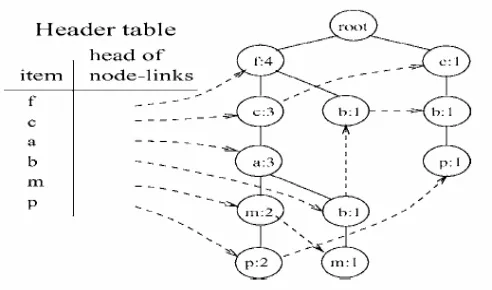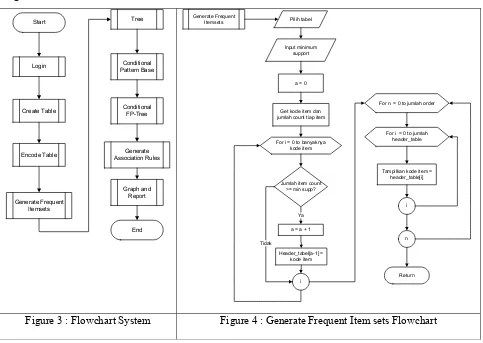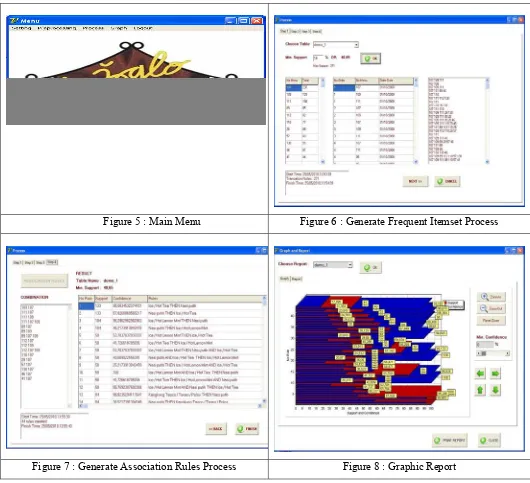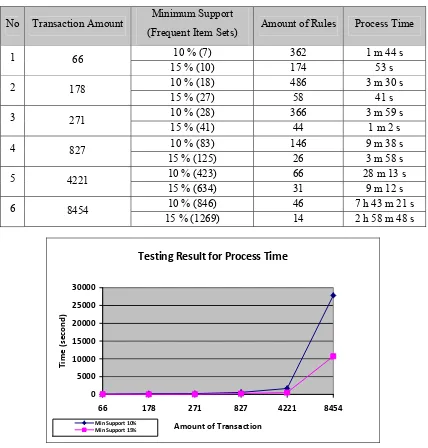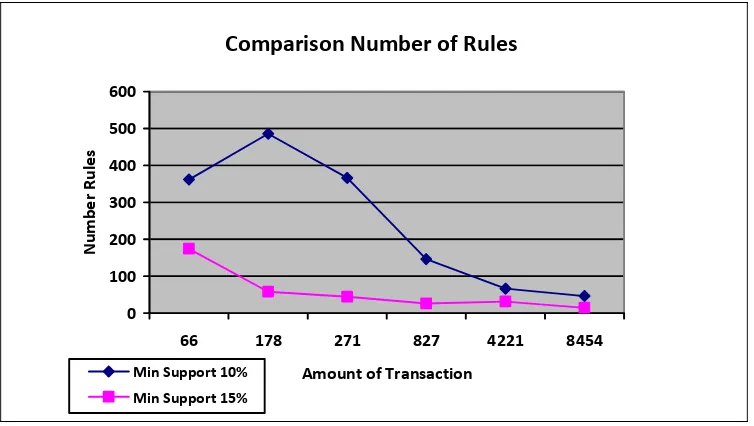A Decision Support System for “De Joglo” Restaurant
Using Frequent Pattern Tree Data Mining
Andreas Handojo
1, Gregorius Satia Budhi
2, Nadia Andreani Dwiyono
3Department of Informatics Engineering, Faculty of Industrial Technology, Petra Christian University Siwalankerto 121-131, Surabaya 60236, Indonesia
+62-31-2983455
1
[email protected], 2 [email protected]
1.
Introduction
Now days, the technology developments in Indonesia is increasing fast. There’s so many companies that use computer technology to obtain information, this is including on the restaurants that use computer technology to recording sales transactions and data storage system. For a small restaurant, such technology may be sufficient for managers to making decisions. But, unlike on the quite large restaurant, which has more variety menu and many different models of customers. This will make managers will have more difficulty to decide anything because the data that must be consider and processed is quite a lot.
So a system that can assist managers on making decisions that needed. Therefore in this research, will be build a computer based system that process sales data using Frequent Pattern tree data mining to create a decision support system for the restaurant manager. For example, if customers order food A, usually customers will order food B. So, the restaurant can increase sales of food A and food B by made it a food package that contains both of the food. But, even though the system can issue a correlation between sales order, expertise from the manager is still needed, for example to predict whether the decision is appropriate to be applied or not.
2.
Data Mining
Data mining is a process to discover interesting knowledge from large amounts of data that stored in the database [1]. Technically this analysis in general is dedicated to be able to work on large amount of data, with the goal of data mining that produce decisions and conclusions that guaranteed for accuracy. Data mining is also part of the process of Knowledge Discovery in Databases (KDD). KDD process consists of the following steps (Figure 1):
• Data cleaning, remove noise and inconsistent data.
• Data integration, integrating multiple data sources that can be combined.
• Data selection, selection of data relevant to the analysis task is retrieved from the database.
• Data transformation, the process where’s data is transformed or consolidated into a format suitable for processing in data mining.
• Data mining, an essential process in which the method was applied to extract data patterns.
• Pattern evaluation, the process to identify interesting patterns to be represented into the knowledge-based.
Figure 1 : The Process of Knowledge Discovery in Database [1]
3.
Market Basket Analysis
Market Basket Analysis refers to the methodology of the study of consumer habits by finding associations between some of the products offered. For example: finding that the item “A” is usually purchased by the consumer with another item “B” at a specific time. This technique is also called association rule analysis.
The purpose of the market basket is to know what products are purchased simultaneously. Analysis of transaction data to generate a product purchase patterns that often occur on sales. Such information can help sellers to increase sales rate [4]. Suppose in a restaurant, to answer the question "What are the foods that may be ordered at the same visit by customer?" To answer this question market basket analysis can process on the sales transaction data at these restaurants so that the result can be applied to a variety of sales planning in the restaurant, for example in determining the food package [4].
4.
Frequent Pattern Tree (FP Tree) [2][3]
FP-Tree is an efficient algorithm for finding patterns in database transactions. FP-Tree is formed by a root (root) are labeled “null”, that’s a set of sub-tree which consists of certain items and a frequent header table. Each node in the FP-tree contains three important information, (1) label item that inform the type of items that represented the node, (2) count that represents the number of transactions that passes through the node, and (3) link that connects node and label item between node-link.
For more details, we can look at this example, we see the transaction database in Table 1 with minimum support = 3.
Table 1 : Data Transaction
Transaction ID Item Bought Frequent Item 100 f, a, c, d, g, i, m, p f, c, a, m, p 200 a, b, c, f, l, m, o f, c, a, b, m 300 b, f, h, j, o f, b 400 b, c, k, s, p, c, b, p 500 a, f, c, e, l, p, m, n f, c, a, m, p
2. First, we make the root of the tree and give the value "null", and then scan the database for the second time. Scan of the first transaction leads to the development of the first branch of the tree: < (f: 1), (c: 1) (a: 1), (m: 1), (p: 1)>. Note that items in the transactions are sorted based on the items most often ordered. For the second transaction that is <f, c, a, b, m>, because <f, c, a> is already on the path previously during <f, c, a, m, p>, then the number of nodes at this prefix increases 1, and a new node (b: 1) created and linked as a child of (a: 2) and another new node (m: 1) created and linked as a child of (b: 1). After the scanning all the transactions, the node on the tree will produce a tree that can be seen in Figure 2.
Figure 2 : Tree on Example.
3. Looking for a conditional pattern base. In Figure 2 shows the "mine (<f:3, c:3, a:3> | m)" involves three items (a), (c), (f), in a sequence. The first comes from the frequent pattern (am: 3), which is "mine (<f:3, c:3> | am)". The second comes from the frequent pattern (cm: 3), which is "mine (<f:3> | cm)", and the third only come from frequent pattern (fm: 3). Then do recursion by calling "mine (<f:3, c:3> | pm)" produces (cam: 3), (fam: 3), and call "mine ( <f:3> | cam) ", which produce the longest pattern (fcam: 3). Similarly, by calling" mine (<f:3> | cm) ", producing a pattern (FCM: 3). Thus, the entire sequence involving the "m" is <(m: 3), (am: 3), (cm: 3), (fm: 3), (cam: 3), (fam: 3), (fcam : 3), (fcm: 3)>. This shows that the single path FP-tree mining process can be done by searching all combinations of items in that path.
Next, find the conditional FP-Tree. Support count of each item on each conditional pattern bases are added, and every item that has a number less than the minimum support is removed, as shown in Table 2.
Table 2 : Conditional FP-Tree
Item Cond. pattern base Cond. FP-Tree p {(fcam:2), (cb:1)} {(c:3)} | p
m {(fca:2), (fcab:1)} {(f:3, c:3, a:3)} | m b {(fca:1), (f:1), (c:1)} Ø
a {(fc:3)} {(f:3, c:3)} | a c {(f:3)} {(f:3)} | c
f Ø Ø
So the combination results obtained in Table 3:
Table 3 : FP-Tree Combination
fcm : 3 fa : 3
After the combination is obtained, then searched his association rule by seeking support and confidence
• Support
The design and implementation for this application can be seen on flowchart system Figure 3 and
Figure 4.
After login and make a connection to the database, user can create new table and encode new code for each item (food) in the restaurant database. Then, system can generate frequent itemsets (Figure 4) based on minimum support that define by user and build the FP Tree and show it on report.
This application will be built on computer server with specification below:
• Processor : Intel Centrino Core Duo T2300 @ 1,6 GHz
• Memory : 512 MB
• HardDisk : 80 GB
• Operating System : Microsoft Windows XP Home Edition (5.1)
The main interface from this application will shown on Figure 5 to Figure 8.
Figure 5 : Main Menu Figure 6 : Generate Frequent Itemset Process
6.
TESTING
For testing, this research will process one year period restaurant sales data and the result can be seen on Table 4.
Table 4: Testing Results for Process Time
No Transaction Amount Minimum Support
(Frequent Item Sets) Amount of Rules Process Time
10 % (7) 362 1 m 44 s
66 178 271 827 4221 8454
Amount of Transaction
Figure 9. Results Comparison for Process Time
Comparison Number of Rules
0 100 200 300 400 500 600
66 178 271 827 4221 8454
Amount of Transaction
Num
b
e
r Rules
Min Support 10%
Min Support 15%
Figure 10 : Results Comparison of Number of Generated Rule
From Figure 10, we can see that number of rules that generated not influenced by number of the transaction. The greater the minimum support, the fewer number of rules generated.
7.
Conclusion
From the testing of this application, we have conclusion as follows:
• The smaller the minimum support that user define, then the more frequent item sets generated so the more time is required in carrying out the process.
• Number of Rules that generated not influenced by number of the transaction, but by number of frequent item sets that generated
References
[1] Han, Jiawei., Kamber, Micheline. (2001). Data mining concepts and techniques. Morgan Kaufmann.
[2] Han, J., Pei, J., Yin, Yiwen. (2004). Mining frequent patterns without candidate generation. Simon Fraser University. Netherlands: Kluwer Academic.
[3] He, Z., Xu, X., Deng, S. (2004). A FP-Tree based approach for mining all strongly correlated pairs without candidate generation. USA: World Scientific and Engineering Academy and Society.

